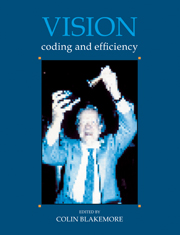Book contents
- Frontmatter
- Contents
- List of Contributors
- Preface
- Reply
- Acknowledgements
- Concepts of coding and efficiency
- Efficiency of the visual pathway
- 5 The design of compound eyes
- 6 The light response of photoreceptors
- 7 Is there more than meets the eye?
- 8 Quantum efficiency and performance of retinal ganglion cells
- 9 Neural interactions underlying direction-selectivity in the rabbit retina
- 10 Detection and discrimination mechanisms in the striate cortex of the Old-World monkey
- Colour
- Brightness, adaptation and contrast
- Development of vision
- Depth and texture
- Motion
- From image to object
- Index
9 - Neural interactions underlying direction-selectivity in the rabbit retina
Published online by Cambridge University Press: 05 May 2010
- Frontmatter
- Contents
- List of Contributors
- Preface
- Reply
- Acknowledgements
- Concepts of coding and efficiency
- Efficiency of the visual pathway
- 5 The design of compound eyes
- 6 The light response of photoreceptors
- 7 Is there more than meets the eye?
- 8 Quantum efficiency and performance of retinal ganglion cells
- 9 Neural interactions underlying direction-selectivity in the rabbit retina
- 10 Detection and discrimination mechanisms in the striate cortex of the Old-World monkey
- Colour
- Brightness, adaptation and contrast
- Development of vision
- Depth and texture
- Motion
- From image to object
- Index
Summary
One of Horace Barlow's early ideas about the processing of visual information was the ‘password’ hypothesis (Barlow, 1961), which has to do with the selection and transmission of information about specific, meaningful (i.e. non-redundant) aspects of the visual world. This notion came, at least in part, from his discovery that some of the frog's retinal ganglion cells had response properties consistent with their being ‘detectors of snapworthy objects’ – flies, for example (Barlow, 1953). Subsequently, the remarkable study by Lettvin, Maturana, McCulloch & Pitts (1959) provided irresistible impetus to the idea that the encoding and transmission of visual information is a highly selective procedure.
From the work on frog retina, it became obvious that the speed and direction of moving stimuli are of considerable importance to the visual system (Lettvin et al, 1959; Maturana et al, 1960). This result was extended to mammalian retina when Barlow & Hill (1963) demonstrated the presence of direction-selective ganglion cells in the rabbit retina. By now, direction- selective ganglion cells have been found in a wide variety of vertebrate retinas. Although these neurons differ somewhat in their response properties, all respond maximally to an appropriate stimulus moving through the receptive field in a particular, ‘preferred’, direction and respond minimally, if at all, to the same stimulus moving in the opposite, ‘null’, direction. Responses to other directions of stimulus movement are less than maximal. As it happens, the topic of direction-selectivity is a very broad one.
- Type
- Chapter
- Information
- VisionCoding and Efficiency, pp. 92 - 102Publisher: Cambridge University PressPrint publication year: 1991
- 1
- Cited by



